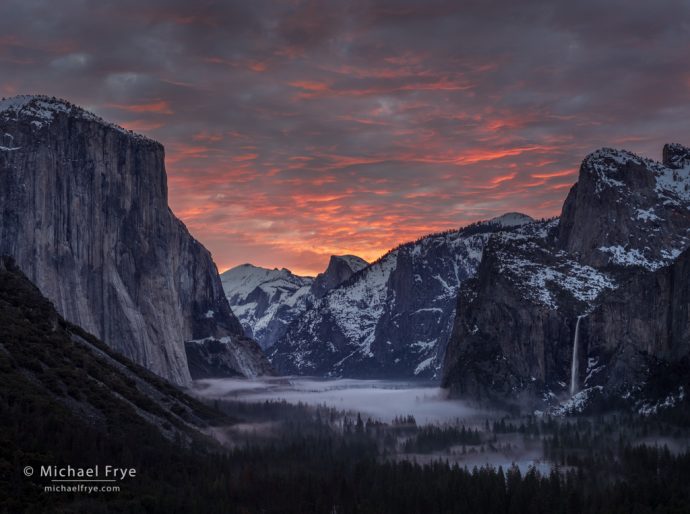
Sunrise from Tunnel View, Yosemite. On this morning the satellite images showed lots of high clouds, but I hoped there might be a gap to the east, allowing the sun to shine through and light the underside of the clouds. And I hoped for mist on the valley floor. That was asking for a lot, but sometimes things work out. The color lasted about three minutes. 50mm, three bracketed exposures, two stops apart, blended with Lightroom’s HDR Merge.
While early February brought lots of snow to Yosemite Valley, over the last three weeks we’ve seen a series of warmer storms, with rain rather than snow. I’d rather have snow, of course, but any weather is more interesting than blue skies. And rain on top of snow is a great mist producer.
Fog or clouds form when the temperature and dew point converge. That means either cooling the air to meet the dew point (like when air rises, and cools, and the water vapor in the air condenses into clouds), or raising the dew point to meet the air temperature (by increasing the amount of moisture in the air).
When rain falls on top of snow, the rain increases the moisture in the air, raising the dew point, while the snow acts like a refrigerator, cooling the air right above the ground. So the temperature and dew point converge, and the result is a fog-generating machine. The valley was filled with mist and fog almost every day for two weeks.
Photographing mist can be challenging, because it moves so quickly. I was standing at Tunnel View one afternoon, photographing the mist swirling around the valley, when a woman nearby asked me if those were clouds out there. I said well yes, and mist, or fog. And she said, “But it’s moving so quickly!” And I said, yes, it does that! It moves really fast.
If you see a composition you have to compose and focus quickly, or the moment will pass. Changing lenses is often pointless unless you can anticipate what might happen. If I see that the mist is moving in a certain direction, or notice that it’s clearing, or thickening, I might be able to change lenses or shift my camera position quickly enough to capture what’s about to happen, rather than what’s already happened.
The other option is to wait, as events sometimes repeat. Recently I saw a misty view of Half Dome and its reflection, and quickly set up a composition, but didn’t have time to find the best camera position, resulting in a foreground cluttered with clumps of grass. The mist dissipated, and I moved on, but not too far, and not before scouting for a better camera position – just in case the mist returned. I kept my eye on the scene, and the mist did come back, so I was able to quickly set up and compose the photograph with a better foreground:
It’s been a really fun winter for photography in Yosemite, with lots of interesting weather – snow, and mist, and sometimes both. You’ll find a few more misty photographs of the valley below.
— Michael Frye
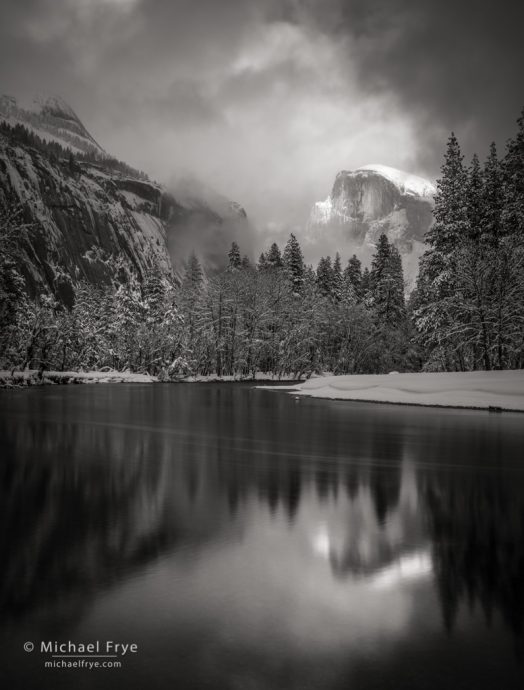
Half Dome, North Dome, and the Merced River with clouds, mist, and snow, Yosemite – made after the last big snowfall. 25mm, 8 seconds at f/11, ISO 50. I used a neutral-density filter to get the slow shutter speed, but I can’t remember which one; probably seven or ten stops.
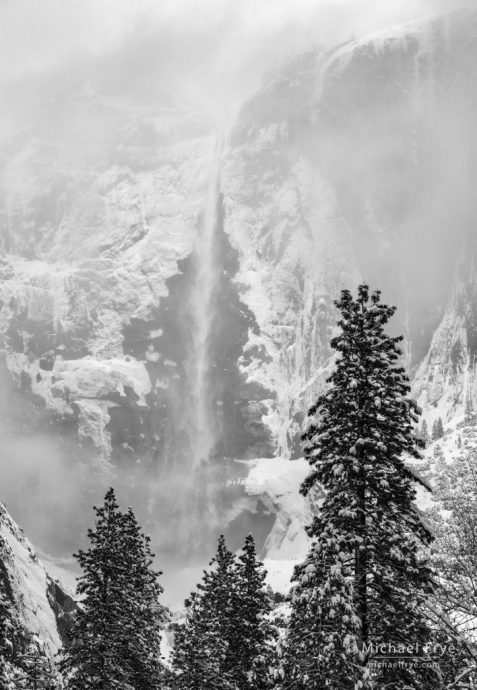
Upper Yosemite Fall in winter, Yosemite. Another image from the last big snowfall. 100mm, 1/125th of a second at f/11, ISO 100.
Related Posts: A Monster Storm; Snow in Yosemite Valley; Snow in Yosemite Valley: Part 2
Michael Frye is a professional photographer specializing in landscapes and nature. He is the author or principal photographer of The Photographer’s Guide to Yosemite, Yosemite Meditations, Yosemite Meditations for Women, Yosemite Meditations for Adventurers, and Digital Landscape Photography: In the Footsteps of Ansel Adams and the Great Masters. He has also written three eBooks: Light & Land: Landscapes in the Digital Darkroom, Exposure for Outdoor Photography, and Landscapes in Lightroom: The Essential Step-by-Step Guide. Michael has written numerous magazine articles on the art and technique of photography, and his images have been published in over thirty countries around the world. Michael has lived either in or near Yosemite National Park since 1983, currently residing just outside the park in Mariposa, California.

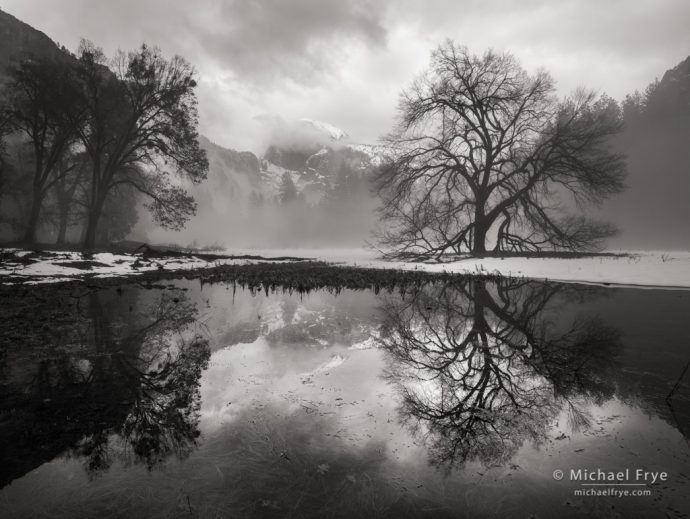
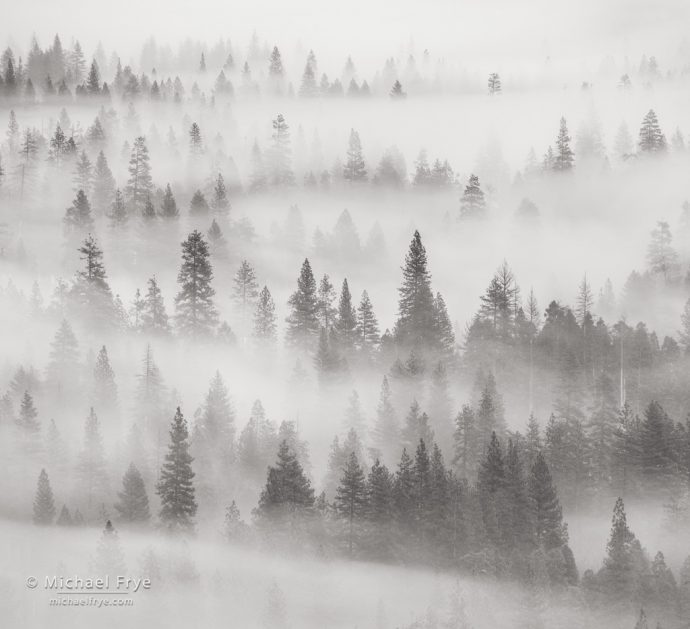
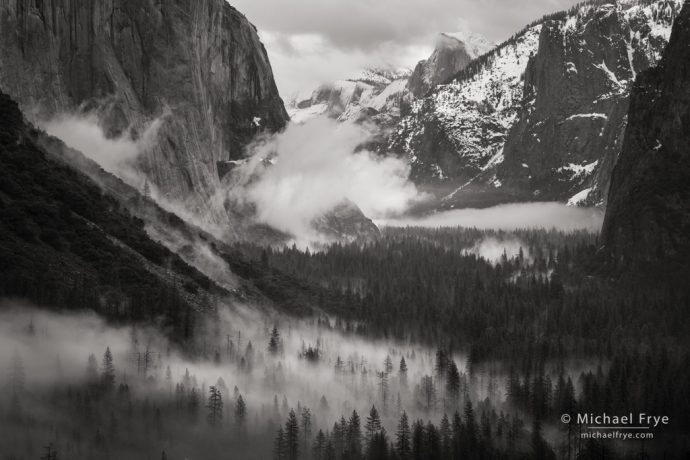








That is an especially stunning tunnel view sunrise. I can’t imagine that you aren’t particularly well-pleased with that one, even with the many many times you must have been there.
Thanks very much!
Excellent sunrise photo, Michael. Misty Trees (#3) is a great composition with the large tree to the right of center a focal point. I like the symmetry of horizontal lines and repeating trees shapes. Good work with the telephoto lens!
Thank you Dan, and I’m glad you like that more subtle image!
I agree, love the composition on #3. Proof a telephoto lens is just as important for landscape as is a wide Angle!
I was referring to upper Yosemite fall winter taken at 100mm. That said, all are wonderful captures!
Thanks Nelson! There’s this new-fangled idea that landscape photography = wide-angle lens. I don’t know where this came from; Ansel Adams never thought that, neither did Edward Weston, or Eliot Porter, or even David Muench, who practically invented the super wide-angle, near-far style of landscape photography – but still made many of his best images with long lenses.
By the way thanks for sharing these amazing images. TTYL
Beautiful Photographs, Thanks for sharing your artistic talent.
Thanks Ken!
Thanks, Michael for these stunning images and your comments about shooting in the mist. I particularly like Half Dome, North Dome … and the misty trees—just beautiful! I’m in North Queensland, Australia right now, where it’s 85 degrees out. Quite a contrast from the weather California has been getting lately. Thanks again.
Thank you Bob! I guess there’s often a weather contrast on opposite sides of the earth. 🙂 I’ve never been to the southern hemisphere, but I’m looking forward to one day watching the sun move from right to left through the sky.
Those are all wonderful Michael. You’re ability to always find variety and not be redundant is impressive. But I really love that first B&W the best. The mist, the reflection, and the mood are really special IMO. Looks like spring flooding of the valley is getting off to an early start this year. 🙂
Thanks very much John!
Wow!
Thanks Sharon!
Beautiful. If you don’t mind sharing, where do you get satellite images from?
Thanks Praveen. For satellite images I look at the GOES satellites:
https://www.star.nesdis.noaa.gov/GOES/index.php
Be sure to pick the GeoColor mode.
I also use the Meteoblue app on my phone for satellite images.